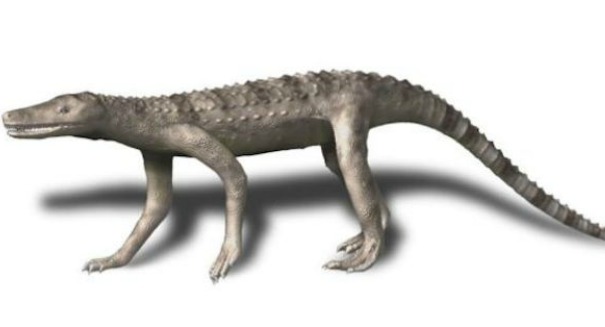
A specimen was uncovered in North Carolina by scientists, who believe that the fearsome beast was at the top of the food chain before dinosaurs arrived.
A huge crocodile that stood on two legs at 9 feet tall with bladelike teeth ruled the swamps of ancient North Carolina, new findings say.
Carnufex carolinensis, the “butcher croc” lived about 230 million years ago and probably walked on its hing legs like a dinosaur, dining on other reptiles and early mammals, according to a LiveScience report.
“Carnufex” means butcher in Latin, so named because its long skull ringed with teeth like blades is reminiscent of a knife, and it probably worked that way, cutting into its prey with ease, according to Lindsay Zanno of NC State University according to the report.
It’s a good reminder that there were some fierce predators during the Triassic period, even before the appearance of the dinosaurs. Crocs were the rulers of the animal kingdom before dinosaurs showed up in the middle of the Triassic and began to dominate in the Jurassic period.
The Triassic period took place between 250 million and 200 million years ago, and the Jurassic occurred during the 200 million years to 150 million years ago timeframe. The Triassic was preceded by an extinction event that hammered the Earth’s biosphere, meaning that the “butcher croc” lived during the time when the Earth was just starting to recover from its former diversity. It was also during this time that the supercontinent of Pangaea began to break apart and drift into the land masses we know today as the continents.
The bones of the butcher croc were discovered in the Pekin Formatoin in Chatham County in North Carolian, and sediments there are estimated to be 231 million years ago. During this time, the area would have been near the Earth’s equator and a very warm and wet environment where crocodile-like species could thrive.
The fact that the butcher croc didn’t have to live around predatory dinosaurs probably allowed it to grow to such a large and dominant predator.
It’s an unusual specimen, too. The scientists found that it had a strange texture within the bones, with lots of pits and grooves in the skull, Zanno said according to the report. Such ornamentation is interesting because while it’s seen in crocs today, it wasn’t in their ancestors.
Carnufex probably had some other unique features that it shared with other species, with teeth that are typically found in meat-eating dinosaurs, and skeletal features similar to that of rauisuchids, a dinosaurlike reptile that was a top predator at the time.
However, Earth went through another extinction event at the end of the Triassic that wiped out the butcher croc, along with many other predators, leaving mostly smaller creatures. That extinction event, which marked the beginning of the famous Jurassic period and the reign of the dinosaurs, happened 201.3 million years ago. Scientists don’t currently know what caused it: some have suggested it was gradual climate change, while others an asteroid impact or huge volcanic eruption, but so far no definitive proof has been put forward.
The famous extinction event that wiped out the dinosaurs actually extended through the Jurassic period and into the Cretaceous, which ended 66 million years ago. The Cretaceous period featured a warm climate and high sea levels, creating plenty of inland seas where sea creatures thrived as dinosaurs remained the dominant predator on land.

The Cretaceous-Paleogene marked the end of the era and wiped out three-quarters of plant and naimal species on Earth, and marked the beginning of the Cenozoic Era, which were are part of today.
Regardless, as the butcher crock went extinct, small crocodylomorphs and theropods went on to survive, and led to the evolution of predatory dinosaurs, while ancestors of the crocodile were forced into the secondary predator role — a role that has suited them just fine ever since.
It was therapod dinosaurs that started to get big, and modern crocs took the more survivable smaller predatory role with sleeker bodies and longer limbs rather than the bone-crushing size of the butcher croc. In fact, one graduate student at NC State told LiveScience that the crocs from the Jurassic could be described as a modern-day fox with alligator skin instead of fur.
Crocodylomorpha refers to a group of what are known as archosaurs, which includes crocodilians and their extinct relatives. This group was very diverse back during the Msozoic and Cenozoic eras, which eventually turned into smaller, active terrestial creatures that again adapted to become marine species and eventually the hybrid terrestial and aquatic species we know today.
Theropods, meanwhile, first appeared in the late Triassic and turned into the dinosaurs from the Jurassic after getting their big break. Scientists believe birds evolved from theropods.
The findings were published in the journal Scientific Reports.
Leave a Reply